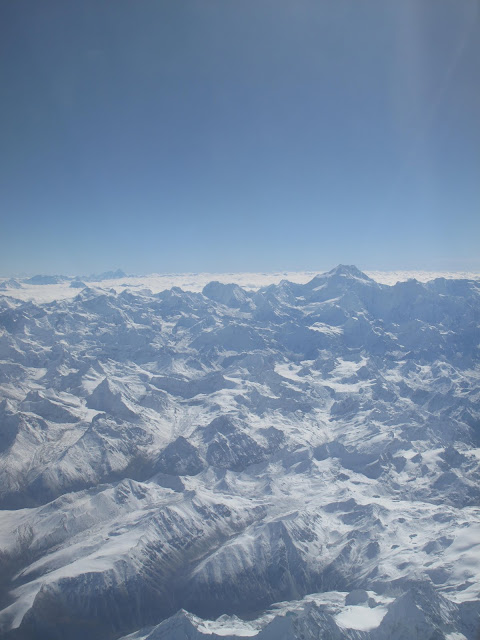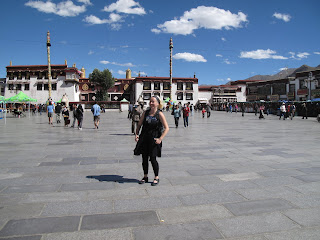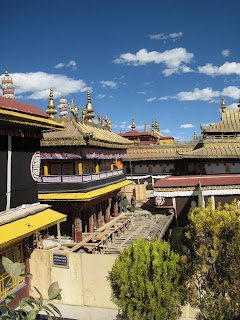I had been told that the Jokhang was and still is the beating heart of Tibet.
Pilgrims prostrate themselves in front of its squat square exterieur, Tibetans continuously do laps of the temple as a "kora" in a clockwise direction.
During its history its seen many Dalai Lamas, witnessed many festivals with butter sculptures and thousands of monks and pilgrims, and i'm sure as it does today seen many market stalls - But then unlike now it wasn't situated on a big tiled Chinese square. Complete with 60th anniversary celebratory flowers and 4 units of soldiers.

I first visited the Jokhang the night before. It was colder than i expected, and the square was lit by really orange street lamps, and populated by so many soldiers it was almost a scary experience. Its a shame the "heart" of Tibetans religious passion has to be so heavily armed. Apparently many Chinese walk in an anti-clockwise direction round the Jokhang to show irreverance, or just because they dont care. (I saw this many times) Apparently there are so many guards because there have been incidents where Kampas have attacked Chinese for their anti-clockwise behaviour. I would say the whole of Tibet seems heavily populated by armed guards, and the concentration of them seems directly related to how important the place is to the Tibetans.
As time goes on unfortunately my trip becomes more like a memory and less like real life.
So to return to the Jokhang the afternoon of my birthday, the sky still blue as forever i went with the other tourists inside the Jokhang. There are less pilgrims and prostrations during the day time than there is in the evening or the morning, as i guess people are at work. There were once again many Chinese parties of tourists. When you step inside you realise its like a courtyard within a courtyard. And a lot of it is being worked on. Or demolished and rebuilt.
The inner room is square with giant paintings on the walls and different buddhas housed in each room around the periphery. In one of the rooms is the statue that the Chinese Princess brought from China with her - this is particularly popular with the Chinese tourists.
In the outer courtyard the pickaxes are weilded on the roof of the building being altered. And on the rest of roof you get the most fantastic view.

I can imagine that the Jokhang was once teeming with monks. I dont know the exact numbers but at the Jokhang that afternoon there were only a handful of monks. One of them was very friendly in front of the big statue of Buddha and Padhmasambava in the inner temple. He was very smiley, but the atmosphere quickly changed as this young (maybe 20?) Chinese guy stood right next to him and listened and questioned everything he said to me. It was unreal how aggressive this guys whole stance was. I only wanted to ask the monk about Buddhism, i was well aware i shouldn't ask anything provocative, especially not with a guy like that listening in. I felt very sorry for the monks in the Jokhang, not only are they not allowed to wear normal robes anymore, and no only have their numbers dwindled from the thousands to under a hundred, but they are caged and spied on - its horrendous really. On my way out of the temple there was a door ajar on the right hand side and i peered in, and it was full of led lights and buttons and cctv equipment. Like a big panel you see in James Bond movies to trigger a nuclear explosion. Stuck in the Jokhang temple to spy on people. Charming.
I'm trying not to be hard on the Chinese and i understand the situation is so fraught and difficult. And i know its not all Chinese, i've said all that in my previous blogs, but it all comes across very much as if the temples and traditions of the Tibetans are only tolerated a) for tourism and b) to aid oppression
Anyway, back to my day!
The views from the roof of the Jokhang are really spectacular, and its where i saw the few monks that still inhabit the temple. They even posed for some photos with Chinese tourists.
The Jokhang is surrounded by market stalls and shops, and i was determined to get my sister a birthday present whilst in Lhasa.
"Lookey lookey" the ladies call out as you walk past. I dislike being the tourist in the market, and such an obvious target, but with Tess it was quite a lot of fun, and i soon saw myself parting with money for a load of bracelets for my friends and just as i was heading back to the hotel, a spent all the rest of my Yen on a necklace for my sister. I still have no idea if i got a good deal, but i had a lot of fun bargaining for it, and my sister likes it - here's the lady i bought it off - i met her whole family in the process!
I went into some of the shops surrounding the Jokhang thinking i would get my sister something there, but as you walk further into the shop, you see that they are clearly Chinese establishments and so i walked out. Again, and again.
So, Potala, Norbulingka, Jokhang and shopping on my birthday and next i had a "suprise" to get ready for in my traditional Tibetan costume.
































